Vittorio Castelli
IBM Research AI, T.J. Watson Research Center, New York, USA
RAG-QA Arena: Evaluating Domain Robustness for Long-form Retrieval Augmented Question Answering
Jul 19, 2024Abstract:Question answering based on retrieval augmented generation (RAG-QA) is an important research topic in NLP and has a wide range of real-world applications. However, most existing datasets for this task are either constructed using a single source corpus or consist of short extractive answers, which fall short of evaluating large language model (LLM) based RAG-QA systems on cross-domain generalization. To address these limitations, we create Long-form RobustQA (LFRQA), a new dataset comprising human-written long-form answers that integrate short extractive answers from multiple documents into a single, coherent narrative, covering 26K queries and large corpora across seven different domains. We further propose RAG-QA Arena by directly comparing model-generated answers against LFRQA's answers using LLMs as evaluators. We show via extensive experiments that RAG-QA Arena and human judgments on answer quality are highly correlated. Moreover, only 41.3% of the most competitive LLM's answers are preferred to LFRQA's answers, demonstrating RAG-QA Arena as a challenging evaluation platform for future research.
From Instructions to Constraints: Language Model Alignment with Automatic Constraint Verification
Mar 10, 2024Abstract:User alignment is crucial for adapting general-purpose language models (LMs) to downstream tasks, but human annotations are often not available for all types of instructions, especially those with customized constraints. We observe that user instructions typically contain constraints. While assessing response quality in terms of the whole instruction is often costly, efficiently evaluating the satisfaction rate of constraints is feasible. We investigate common constraints in NLP tasks, categorize them into three classes based on the types of their arguments, and propose a unified framework, ACT (Aligning to ConsTraints), to automatically produce supervision signals for user alignment with constraints. Specifically, ACT uses constraint verifiers, which are typically easy to implement in practice, to compute constraint satisfaction rate (CSR) of each response. It samples multiple responses for each prompt and collect preference labels based on their CSR automatically. Subsequently, ACT adapts the LM to the target task through a ranking-based learning process. Experiments on fine-grained entity typing, abstractive summarization, and temporal question answering show that ACT is able to enhance LMs' capability to adhere to different classes of constraints, thereby improving task performance. Further experiments show that the constraint-following capabilities are transferable.
NewsQs: Multi-Source Question Generation for the Inquiring Mind
Feb 28, 2024Abstract:We present NewsQs (news-cues), a dataset that provides question-answer pairs for multiple news documents. To create NewsQs, we augment a traditional multi-document summarization dataset with questions automatically generated by a T5-Large model fine-tuned on FAQ-style news articles from the News On the Web corpus. We show that fine-tuning a model with control codes produces questions that are judged acceptable more often than the same model without them as measured through human evaluation. We use a QNLI model with high correlation with human annotations to filter our data. We release our final dataset of high-quality questions, answers, and document clusters as a resource for future work in query-based multi-document summarization.
Few-Shot Data-to-Text Generation via Unified Representation and Multi-Source Learning
Aug 10, 2023Abstract:We present a novel approach for structured data-to-text generation that addresses the limitations of existing methods that primarily focus on specific types of structured data. Our proposed method aims to improve performance in multi-task training, zero-shot and few-shot scenarios by providing a unified representation that can handle various forms of structured data such as tables, knowledge graph triples, and meaning representations. We demonstrate that our proposed approach can effectively adapt to new structured forms, and can improve performance in comparison to current methods. For example, our method resulted in a 66% improvement in zero-shot BLEU scores when transferring models trained on table inputs to a knowledge graph dataset. Our proposed method is an important step towards a more general data-to-text generation framework.
Generate then Select: Open-ended Visual Question Answering Guided by World Knowledge
May 30, 2023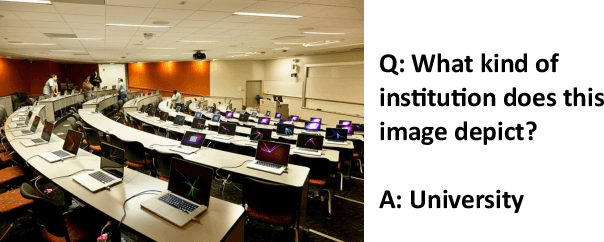


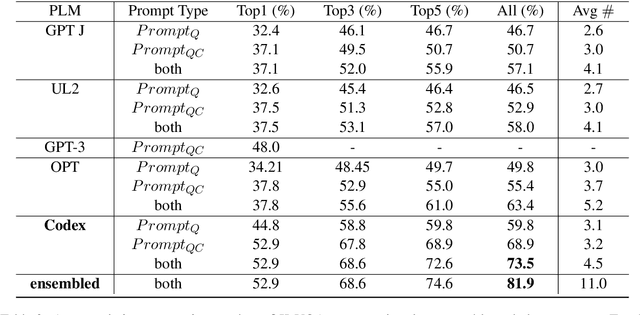
Abstract:The open-ended Visual Question Answering (VQA) task requires AI models to jointly reason over visual and natural language inputs using world knowledge. Recently, pre-trained Language Models (PLM) such as GPT-3 have been applied to the task and shown to be powerful world knowledge sources. However, these methods suffer from low knowledge coverage caused by PLM bias -- the tendency to generate certain tokens over other tokens regardless of prompt changes, and high dependency on the PLM quality -- only models using GPT-3 can achieve the best result. To address the aforementioned challenges, we propose RASO: a new VQA pipeline that deploys a generate-then-select strategy guided by world knowledge for the first time. Rather than following the de facto standard to train a multi-modal model that directly generates the VQA answer, RASO first adopts PLM to generate all the possible answers, and then trains a lightweight answer selection model for the correct answer. As proved in our analysis, RASO expands the knowledge coverage from in-domain training data by a large margin. We provide extensive experimentation and show the effectiveness of our pipeline by advancing the state-of-the-art by 4.1% on OK-VQA, without additional computation cost. Code and models are released at http://cogcomp.org/page/publication_view/1010
Benchmarking Diverse-Modal Entity Linking with Generative Models
May 27, 2023Abstract:Entities can be expressed in diverse formats, such as texts, images, or column names and cell values in tables. While existing entity linking (EL) models work well on per modality configuration, such as text-only EL, visual grounding, or schema linking, it is more challenging to design a unified model for diverse modality configurations. To bring various modality configurations together, we constructed a benchmark for diverse-modal EL (DMEL) from existing EL datasets, covering all three modalities including text, image, and table. To approach the DMEL task, we proposed a generative diverse-modal model (GDMM) following a multimodal-encoder-decoder paradigm. Pre-training \Model with rich corpora builds a solid foundation for DMEL without storing the entire KB for inference. Fine-tuning GDMM builds a stronger DMEL baseline, outperforming state-of-the-art task-specific EL models by 8.51 F1 score on average. Additionally, extensive error analyses are conducted to highlight the challenges of DMEL, facilitating future research on this task.
UNITE: A Unified Benchmark for Text-to-SQL Evaluation
May 26, 2023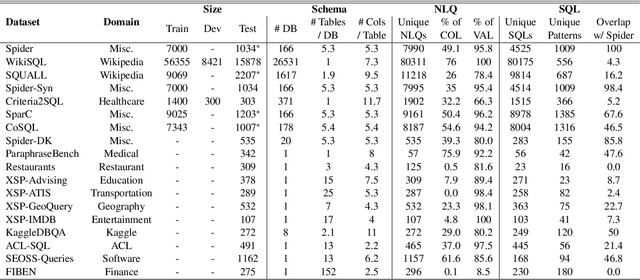
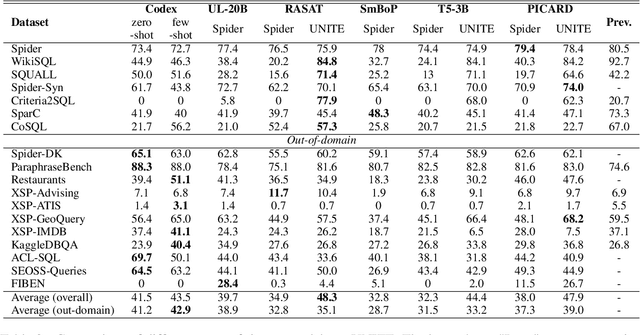
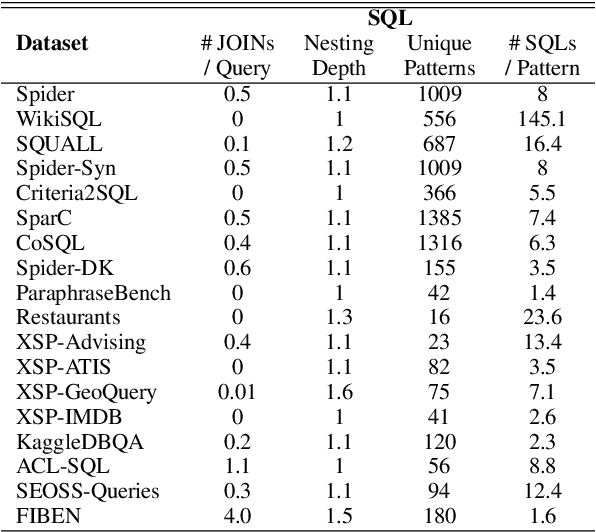
Abstract:A practical text-to-SQL system should generalize well on a wide variety of natural language questions, unseen database schemas, and novel SQL query structures. To comprehensively evaluate text-to-SQL systems, we introduce a \textbf{UNI}fied benchmark for \textbf{T}ext-to-SQL \textbf{E}valuation (UNITE). It is composed of publicly available text-to-SQL datasets, containing natural language questions from more than 12 domains, SQL queries from more than 3.9K patterns, and 29K databases. Compared to the widely used Spider benchmark \cite{yu-etal-2018-spider}, we introduce $\sim$120K additional examples and a threefold increase in SQL patterns, such as comparative and boolean questions. We conduct a systematic study of six state-of-the-art (SOTA) text-to-SQL parsers on our new benchmark and show that: 1) Codex performs surprisingly well on out-of-domain datasets; 2) specially designed decoding methods (e.g. constrained beam search) can improve performance for both in-domain and out-of-domain settings; 3) explicitly modeling the relationship between questions and schemas further improves the Seq2Seq models. More importantly, our benchmark presents key challenges towards compositional generalization and robustness issues -- which these SOTA models cannot address well. \footnote{Our code and data processing script will be available at \url{https://github.com/XXXX.}}
Pre-training Intent-Aware Encoders for Zero- and Few-Shot Intent Classification
May 24, 2023Abstract:Intent classification (IC) plays an important role in task-oriented dialogue systems as it identifies user intents from given utterances. However, models trained on limited annotations for IC often suffer from a lack of generalization to unseen intent classes. We propose a novel pre-training method for text encoders that uses contrastive learning with intent psuedo-labels to produce embeddings that are well-suited for IC tasks. By applying this pre-training strategy, we also introduce the pre-trained intent-aware encoder (PIE). Specifically, we first train a tagger to identify key phrases within utterances that are crucial for interpreting intents. We then use these extracted phrases to create examples for pre-training a text encoder in a contrastive manner. As a result, our PIE model achieves up to 5.4% and 4.0% higher accuracy than the previous state-of-the-art pre-trained sentence encoder for the N-way zero- and one-shot settings on four IC datasets.
Taxonomy Expansion for Named Entity Recognition
May 22, 2023Abstract:Training a Named Entity Recognition (NER) model often involves fixing a taxonomy of entity types. However, requirements evolve and we might need the NER model to recognize additional entity types. A simple approach is to re-annotate entire dataset with both existing and additional entity types and then train the model on the re-annotated dataset. However, this is an extremely laborious task. To remedy this, we propose a novel approach called Partial Label Model (PLM) that uses only partially annotated datasets. We experiment with 6 diverse datasets and show that PLM consistently performs better than most other approaches (0.5 - 2.5 F1), including in novel settings for taxonomy expansion not considered in prior work. The gap between PLM and all other approaches is especially large in settings where there is limited data available for the additional entity types (as much as 11 F1), thus suggesting a more cost effective approaches to taxonomy expansion.
Comparing Biases and the Impact of Multilingual Training across Multiple Languages
May 18, 2023Abstract:Studies in bias and fairness in natural language processing have primarily examined social biases within a single language and/or across few attributes (e.g. gender, race). However, biases can manifest differently across various languages for individual attributes. As a result, it is critical to examine biases within each language and attribute. Of equal importance is to study how these biases compare across languages and how the biases are affected when training a model on multilingual data versus monolingual data. We present a bias analysis across Italian, Chinese, English, Hebrew, and Spanish on the downstream sentiment analysis task to observe whether specific demographics are viewed more positively. We study bias similarities and differences across these languages and investigate the impact of multilingual vs. monolingual training data. We adapt existing sentiment bias templates in English to Italian, Chinese, Hebrew, and Spanish for four attributes: race, religion, nationality, and gender. Our results reveal similarities in bias expression such as favoritism of groups that are dominant in each language's culture (e.g. majority religions and nationalities). Additionally, we find an increased variation in predictions across protected groups, indicating bias amplification, after multilingual finetuning in comparison to multilingual pretraining.
 Add to Chrome
Add to Chrome Add to Firefox
Add to Firefox Add to Edge
Add to Edge